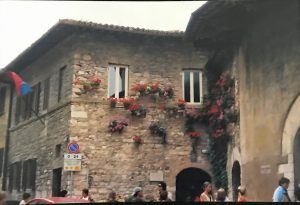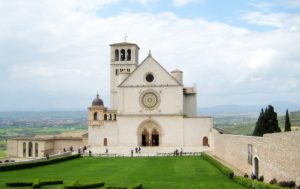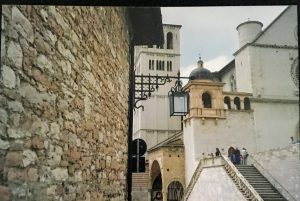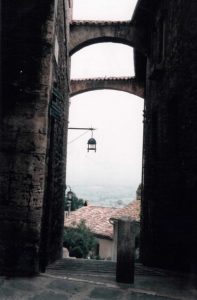
Travel: Assisi, Italy
A Medieval wonder

Assisi, the hometown of St Francis, is the prettiest hill town ever, according to Sheila Kumar.
It is a grey day, leaden clouds scudding over dull skies, a threat of rain in the moisture-laden air, the day we visit Assisi, in the Umbrian region of Italy.
I refuse to be cowed down by the elements, though. I have a longstanding and firm belief that the ‘Sheila Effect’ would soon come into effect and all would be well.
All is well
The ‘Sheila Effect’ is when everything falls into place after a less-than-auspicious beginning. Sure enough, by the time we visit the crypt of the gentle saint, we emerge into bright sunlight; nary a cloud above and the valley of Santa Maria Angeli sparkling green and gold below.
The green of the olive groves, the gold from the sun glinting off the beautiful gilded statue of Santa Maria.
Assisi, a tiered sprawl of buildings in pink and gray stone, cobbled streets, shops, churches and the ubiquitous piazzas with their fountains, is perched on the slopes of Monte Subasio, with olive groves and sunflower fields making a colourful hedge.

Medieval town
Eight fortified entrance portals and a long belt of town walls stand as they stood in the Middle Ages, guarding and protecting this Medieval town.
Assisi has always been a major pilgrimage destination for Christians coming to pray at the Basilica of San Francisco; because of the frequent all- religion meets held in town, the odd Hindu priest, Buddhist lama or rabbi too, aren’t hard to find.
Our tour guide Giuseppe, who could have auditioned for a role in the Godfather trilogy any time, tells us wryly of the time the earlier Pope had held an all-religions conclave in Assisi… “so many commandos, so many guns trained on churches, so much pressure to stay peaceful!”
Assisi is the hometown of Italy’s patron saint, St Francis, founder of one of the world’s largest monastic orders, and considered just about the holiest person to walk the earth after Christ. St. Francis grew up here, the son of a rich merchant and a wild ‘un.
When the town of Assisi went to war with Perugia, the young Francis was captured and spent a year in prison. Once free, he changed his ways, gave all he owned away, tended to the destitute, the ill, and animals, preached love, labour and piety.

The Basilica of San Francesco is, of course, the centrepoint of Assisi. The complex of the Basilica, which predates the Vatican by 300 years, is composed of two churches, built one above the other. The lower church is where St. Francis is buried and is a marvel for its decorated vaulted ceilings painted dark blue and dotted with stars.
It has frescoes by some of the greats Masters like Cimabue, Giotto, Lorenzetti and Simone Martini. Above ground in the upper church, the brilliant blue of the lapis on the ceiling is another jaw-dropping marvel.
Giotto’s frescoes illustrating the life of St. Francis in loving detail adorn this part of the Basilica, which holds the twin distinctions of being Italy’s first Gothic cathedral and with the oldest stained glass windows in the country.
The churches of St. Clare and St. Peter, the former a Gothic building dating back to 1265, the latter older, with three evocative Rose windows, are other important churches in Assisi.
In the main piazza which stands on the ancient Forum, the atmosphere is a throwback to pre-Christian times, as testified by the magnificent temple of Minerva, built during the Augustan period, its columns and Corinthian capitals as well preserved as the rest of the town.

The Indian connect
I make two discoveries-of-sorts in Assisi: one that my forbears wandered all the way over from India to these parts, in pre-Christian times. Well, if not my forbears exactly, Indians, anyway. They were part of the early south-east Asian diaspora in these parts, only to be enslaved by the Romans later on.
The other discovery is not an original one: it is that any trip to Italy would be incomplete without the inclusion of Assisi. It’s fascinating to trawl the cobbled lanes that ascend and descend at almost every corner, all the while affording vistas of the panorama down in the plains.
Here we come upon pink stone stairs winding their way up secluded homes and monasteries; there we come upon a house front with masses of red flowers growing on the walls.
Elsewhere, we stumble upon the Italian version of Lush, a store chock- full of the most fragrant soaps, lotions and potions, wafting its heavenly fragrance all down the street.
Other shops stock, along with the usual religious artifacts, a great variety of locally made ceramics, all gaily painted in vivid blues, oranges, lemons yellows. Local wines and olive oil are sold in beautiful flacons and bottles.
Little cafes supply endless shots of the strong espressos, eateries serve hot pizza, lasagne and pasta. And in one ceramics shop, I come across a leaflet advertising a spiritual retreat in Assisi by one Swami Kriyananda.

With a population of less than 3,000, Assisi sees an average of four to five million visitors every year; pilgrims, art lovers, tourists.
For all the many feet that tread these cobblestones, there is a serene ambience that defines Assisi, that makes this beautiful Medieval town such a compelling attraction.
This ran in DECCAN HERALD of sometime 2012.
Related Links: